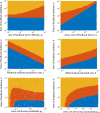Spatial dynamics of feedback and feedforward regulation in cell lineages
- PMID: 35522694
- PMCID: PMC9116666
- DOI: 10.1371/journal.pcbi.1010039
Spatial dynamics of feedback and feedforward regulation in cell lineages
Abstract
Feedback mechanisms within cell lineages are thought to be important for maintaining tissue homeostasis. Mathematical models that assume well-mixed cell populations, together with experimental data, have suggested that negative feedback from differentiated cells on the stem cell self-renewal probability can maintain a stable equilibrium and hence homeostasis. Cell lineage dynamics, however, are characterized by spatial structure, which can lead to different properties. Here, we investigate these dynamics using spatially explicit computational models, including cell division, differentiation, death, and migration / diffusion processes. According to these models, the negative feedback loop on stem cell self-renewal fails to maintain homeostasis, both under the assumption of strong spatial restrictions and fast migration / diffusion. Although homeostasis cannot be maintained, this feedback can regulate cell density and promote the formation of spatial structures in the model. Tissue homeostasis, however, can be achieved if spatially restricted negative feedback on self-renewal is combined with an experimentally documented spatial feedforward loop, in which stem cells regulate the fate of transit amplifying cells. This indicates that the dynamics of feedback regulation in tissue cell lineages are more complex than previously thought, and that combinations of spatially explicit control mechanisms are likely instrumental.
Conflict of interest statement
The authors have declared that no competing interests exist.
Figures




Similar articles
-
Spatial dynamics of multistage cell lineages in tissue stratification.Biophys J. 2010 Nov 17;99(10):3145-54. doi: 10.1016/j.bpj.2010.09.034. Biophys J. 2010. PMID: 21081061 Free PMC article.
-
Feedback regulation in multistage cell lineages.Math Biosci Eng. 2009 Jan;6(1):59-82. doi: 10.3934/mbe.2009.6.59. Math Biosci Eng. 2009. PMID: 19292508 Free PMC article.
-
Control of cell fraction and population recovery during tissue regeneration in stem cell lineages.J Theor Biol. 2018 May 14;445:33-50. doi: 10.1016/j.jtbi.2018.02.017. Epub 2018 Feb 20. J Theor Biol. 2018. PMID: 29470992
-
[Lineage-switching by pluripotent cells derived from adults].J Soc Biol. 2001;195(1):39-46. J Soc Biol. 2001. PMID: 11530498 Review. French.
-
Epidermal cell lineage.Biochem Cell Biol. 1998;76(6):889-98. doi: 10.1139/bcb-76-6-889. Biochem Cell Biol. 1998. PMID: 10392703 Review.
Cited by
-
Dynamically adjusted cell fate decisions and resilience to mutant invasion during steady-state hematopoiesis revealed by an experimentally parameterized mathematical model.Proc Natl Acad Sci U S A. 2024 Sep 17;121(38):e2321525121. doi: 10.1073/pnas.2321525121. Epub 2024 Sep 9. Proc Natl Acad Sci U S A. 2024. PMID: 39250660 Free PMC article.
-
Insight into the Potential of Somatostatin Vaccination with Goats as a Model: From a Perspective of the Gastrointestinal Microbiota.Animals (Basel). 2025 Mar 4;15(5):728. doi: 10.3390/ani15050728. Animals (Basel). 2025. PMID: 40076011 Free PMC article.
-
Aging effects on osteoclast progenitor dynamics affect variability in bone turnover via feedback regulation.JBMR Plus. 2024 Jan 4;8(1):ziad003. doi: 10.1093/jbmrpl/ziad003. eCollection 2024 Jan. JBMR Plus. 2024. PMID: 38690125 Free PMC article.

